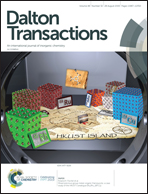Four- and five-coordinate aluminum complexes supported by N,O-bidentate β-pyrazylenolate ligands: synthesis, structure and application in ROP of ε-caprolactone and lactide†
Abstract
In this paper we report a series of Al(III) complexes supported by N,O-bidentate β-pyrazyl functionalized enolate ligands HL1–HL5 (L = (6-Me-2,5-C4H2N2)–CH![[double bond, length as m-dash]](https://www.rsc.org/images/entities/char_e001.gif) C(R)–O–), (R = tBu, Ph, p-tolyl, p-OMePh, o-tolyl) and their exploitation for the ring-opening polymerization of ε-caprolactone (ε-CL) and rac-lactide (rac-LA). The structures of the form LAlMe2 (1a–5a) or L2AlMe (1b–4b) were isolated depending on the ligand or stoichiometry of complexation. The investigation of these complexes toward the ROP of both ε-CL and rac-LA under the same conditions showed that dimethyl-aluminum complexes LAlMe2 (1a–5a) gave a higher activity than monomethyl-aluminum complexes L2AlMe (1b–4b). Meanwhile, monomethyl-aluminum complexes 1b–4b promoted the ring-opening polymerization with a better control over molecular weights and polydispersities than 1a–5a. Moreover, all of the LAlMe2 and L2AlMe produced PLA with strong isotactic bias (Pm up to 0.77) and narrow distributions. Generally, a β-pyrazyl enolate system exhibited significantly higher catalytic activity for the ROP of ε-CL and rac-LA than the analogous β-quinolyl enolate systems reported recently. The results are discussed in terms of electronic and steric properties affected by the substituents on the ligands.
C(R)–O–), (R = tBu, Ph, p-tolyl, p-OMePh, o-tolyl) and their exploitation for the ring-opening polymerization of ε-caprolactone (ε-CL) and rac-lactide (rac-LA). The structures of the form LAlMe2 (1a–5a) or L2AlMe (1b–4b) were isolated depending on the ligand or stoichiometry of complexation. The investigation of these complexes toward the ROP of both ε-CL and rac-LA under the same conditions showed that dimethyl-aluminum complexes LAlMe2 (1a–5a) gave a higher activity than monomethyl-aluminum complexes L2AlMe (1b–4b). Meanwhile, monomethyl-aluminum complexes 1b–4b promoted the ring-opening polymerization with a better control over molecular weights and polydispersities than 1a–5a. Moreover, all of the LAlMe2 and L2AlMe produced PLA with strong isotactic bias (Pm up to 0.77) and narrow distributions. Generally, a β-pyrazyl enolate system exhibited significantly higher catalytic activity for the ROP of ε-CL and rac-LA than the analogous β-quinolyl enolate systems reported recently. The results are discussed in terms of electronic and steric properties affected by the substituents on the ligands.



 Please wait while we load your content...
Please wait while we load your content...